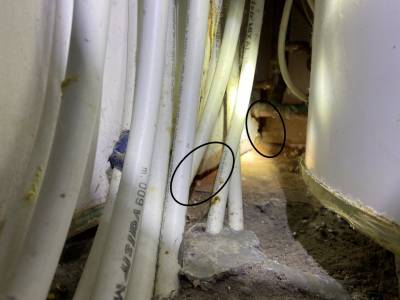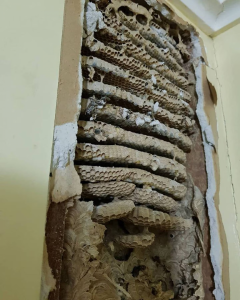Suggestions on how to seal these gaps and holes in very tight space
Our HW cylinder is in the utility room, and the gap between the cylinder and the wall is extremely narrow. The previous owners didn't seal the gap between the floor and wall in a couple of places and there's a large hole around the pipework that vanishes into the walls. This used to be OK until last year when we had wasps nest under the utility room roof. Throughout the summer into autumn we had wasps emerging from the HW cylinder cupboard as they made their way down from the roof and out via the gaps and holes into the utility room.
Given the extremely tight space to work in, does anyone have any suggestions on a product (perhaps an expanding foam) that we could safely use to fill these gaps and stop the wasps coming down if they nest in the same place again?
I'm open to suggestions and good ideas.
Get a copy of The Ultimate Guide to Heat Pumps
Subscribe and follow our YouTube channel!
I have it on good authourity that wasps do not reuse the same nest.
Retrofitted 11.2kw Mitsubishi Ecodan to new radiators commissioned November 2021.
14 x 500w Monocrystalline solar panels.
2 ESS Smile G3 10.1 batteries.
ESS Smile G3 5kw inverter.
Posted by: @editoras they made their way down from the roof and out via the gaps and holes into the utility room.
... as they made their way down through what?
... the cavity/gap within the internal wall?
The risk of sealing up just the gaps at the lower end of such a route, is that you leave them to make as large a nest as they can within the wall.
Does that wall have a timber beam at the top which is visible in the loft space?
Save energy... recycle electrons!
Illbruck FM330 pro foam air seal.
or if you can get your hand in buy some Tescon Vana tape and seal the whole rooms perimeter.
You'll need to substantiate why you've identified that specific sealant @homer-boy
What attribute does it have which a generic expanding-foam product doesn't?
Tescon Vana tape is also an unusual product to find being recommended here.
It's intended for airtight seals between insulation, moisture repellent or low-humidity sheeting during construction.
Both products are expensive due to particular mechanical features identified in their specifications.
Save energy... recycle electrons!
@transparent I’ve used both for years and find them the best for air tightness seals.
the foam itself is a specific air tightness foam. Standard foam could apply but I think for the couple of £ per tin it’s better. Also the tape is seal sealing and very robust. Try eBay as you can find rolls reduced.
Well that wasn't the answer I was expecting @homer_boy !
The Illbruck foam differs from generic PU (polyurethane) for two reasons:
- it retains a specified elasticity after curing
- it has greater adhesive properties
Whilst I can think of situations where those attributes would be especially useful, I wouldn't have considered them of significance for the wall-floor gap mentioned by @editor
I asked the question because I'd expected you to raise those issues.
I've checked prices today, and the brands of PU foam which I'd generally use are currently around £55 (for 12).
The Illbruck FM330 is between £112-£120 ish.
So I'd only be buying it if I was particularly after those attributes.
Now if only we could find a foam which incorporates insecticide properties, then @editor would be happy 🤨
Save energy... recycle electrons!
@editor - I've just taken a moment to look if there are any environmentally safe ways to discourage wasps.
The answer is yes! 😎
Predators include: Praying mantis, geckos, hedgehogs and badgers.
Useful to know, but not a great help if you want to prevent a nest inside the wall.
Aversions: wasps don't like certain aromas, including citronella, peppermint and spearmint.
Those would seem to offer a better approach.
You could either stuff mint leaves into the crack at the bottom of the wall,
or alternatively put drops of citronella oil into any crevice through which you think they are entering the house.
As a general deterrent, I can't see any problem with hanging bunches of mint stems in an attic.
They'll slowly dry during the summer, and leave the loft-space smelling great!
Save energy... recycle electrons!
@editor - if you do try any of these 'natural' approaches, please write it up on My Home Farm and add a link to it from here.
There will be others wanting to know what works... and, just as important, what doesn't!
Save energy... recycle electrons!
@transparent, will do. Out of curiosity, why would be against sealing the bottom? The wasps can exit out the top of the roof. Why they choose to come down and exit into the utility room makes very little sense.
Get a copy of The Ultimate Guide to Heat Pumps
Subscribe and follow our YouTube channel!
If those wasps hadn't been exiting behind the water cylinder, how would you have known they were inside the wall?
Unlike bees, they don't limit the size of their nest.
How big do you think it would grow inside the wall cavity before you actually began to hear them?
On the plus side, wasp nests are exothermic.
So, if you wanted to, you could block the bottom of the wall, let them build as much as they want, and increase your EPC 😲
Save energy... recycle electrons!
Posted by: @transparentIf those wasps hadn't been exiting behind the water cylinder, how would you have known they were inside the wall?
Because we can see them entering via the slate roof tiles above the utility room. It's the first year they nested there, and we'd get 8-12 coming down the wall and entering the utility room... we'd open the windows and let them out. But there was a lot more entering and exiting via the roof. Maybe it makes more sense to try and seal the roof and prevent them coming in to start with.
Get a copy of The Ultimate Guide to Heat Pumps
Subscribe and follow our YouTube channel!
- 26 Forums
- 2,378 Topics
- 53.9 K Posts
- 269 Online
- 6,060 Members
Join Us!
Worth Watching
Latest Posts
-
A sneak preview of the onboard compensation curve desig...
By F1p , 5 minutes ago
-
RE: Radiator sizing sanity check
That really, really shouldn't happen and suggests that ...
By JamesPa , 15 minutes ago
-

RE: Solar Power Output – Let’s Compare Generation Figures
@papahuhu They came to ‘axe you’ what you were up to?
By Toodles , 23 minutes ago
-
RE: Cascade 2x Grant Areona 10kw ASHP - Ongoing setup issues
Either complete Bow Locks or at best a marginal effect....
By JamesPa , 59 minutes ago
-

RE: Testing new controls/monitoring for Midea Clone ASHP
I had a look and it looks complicated to me! There may ...
By cathodeRay , 1 hour ago
-
Hi all I’m looking to get some insight on what others...
By Renewables345 , 1 hour ago
-

RE: The Great British Heat Pump Owner Persona Survey: Let's Build Our Archetype!
@mosibi, go on then, complete the survey. Let's get the...
By Mars , 2 hours ago
-
RE: Water Hammer After Heat Pump Install
@jaynieq I wish you luck with this one. I think the ma...
By JamesPa , 3 hours ago
-
RE: Grant ASHP 17.5 kw. weather curve
All sounds good and like you know what you are doing. R...
By JamesPa , 4 hours ago
-
RE: Optimum new build house design for Heat Pump
From first principles I would say: Definitel...
By JamesPa , 19 hours ago
-

RE: Weather compensation- why you should use it
As good a place as any to drop this video:/p>
By Mars , 22 hours ago
-
RE: Forum updates, announcements & issues
@transparent D'Oh - I did look before I posted but I mi...
By dr_dongle , 24 hours ago
-
Compatibility with Samsung AE080RXYDEH
I am new to all this. We have a SamsungAE080RXYDEH that...
By John999 , 24 hours ago
-
RE: New Fogstar 15.5kWh upright solution
@batpred Maybe you should buy your additional batter...
By Bash , 1 day ago
-

RE: Data Accuracy Problem: Daikin 8kW Heat Pump's Onecta App vs MMI Power Consumption
@nursethescreens Yes, comfort and happiness of the fami...
By Toodles , 1 day ago
-
RE: Connecting Growatt SPH5000 over wired ethernet rather than wireless
Thanks folks. I had tried googling an ethernet lab adap...
By z8lccda , 2 days ago
-
RE: Changing from 4-port buffer to volumizer
@toodles I'm not concerned that the behaviour is not no...
By Andy1618 , 2 days ago
-

-

RE: Setback savings - fact or fiction?
I agree, and I think there are two things in play here....
By cathodeRay , 2 days ago
-
RE: Help needed with Grant Aerona 3 issues
First time posting so bear with me. Some bits that have...
By Adamp , 3 days ago








